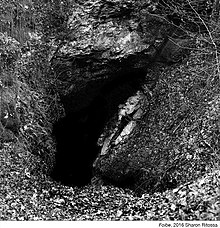Foiba
This article needs additional citations for verification. (December 2019) |

A foiba (plural: foibas or foibe) — jama in South Slavic languages scientific and colloquial vocabulary (borrowed since early research in the Western Balkan Dinaric Alpine karst) — is a type of deep natural sinkhole, doline, or sink, and is a collapsed portion of bedrock above a void. Sinks may be a sheer vertical opening into a cave, or a shallow depression of many hectares. They are common in the Karst (Carso) region shared by Italy and Slovenia, as well as in a karst of Dinaric Alps in Bosnia and Herzegovina, Montenegro and Croatia.
History[]
The term "foiba" was used in the 1770s by Italian naturalist Alberto Fortis who wrote a number of books about karst of Dalmatia.[1] It is an Italian derivative of the Latin fovea, meaning "pit" or "chasm". They are indeed chasms excavated by water erosion, have the shape of an inverted funnel, and can be up to 200 metres (660 ft) deep. Such formations number in the hundreds in Istria.
In karst areas, a sinkhole, sink, or doline is a closed depression draining underground. It can be cylindrical, conical, bowl-shaped or dish-shaped. The diameter ranges from a few to many hundreds of metres. The name "doline" comes from dolina, the Slovenian word for this very common feature. The term "foiba" may also refer to a deep wide chasm of a river at the place where it goes underground.[2]
During and right after the end of World War II, the Yugoslav Partisans killed hundreds of Italians by throwing their still living bodies into the foibe. This event is known as Foibe massacres.
It has been reported that the practice to kill or hide bodies through "foibe" was not totally newly adopted by Yugoslav Partisans, since it was used also by Ustaše some year before,[citation needed] and real initial usage of the pits for hiding bodies seems even older.
Present day[]
This section does not cite any sources. (July 2021) |
Typically, majority of the karst "foibe" are still open, generally without any protection, animals often fall down the initial pit. They can be freely explored in Italy, while in Slovenja and Croatia special permissions are required, and speleological groups of the interested area must be contacted. Foibe was also used to throw garbage, cars, in some case animals with diseases, discarding black waters, this in the decades after WWII. In some of them it is still possible to find First and Second World War residuates, and from time to time also bodies of victims are still getting found. Well organized institutions in Italy, Slovenja and Croatia keep archived the well detailed surveys of each of them.
From the Italian side, for more information is possible to contact the historical speleological group Commissione Grotte Eugenio Boegan located in Trieste.
See also[]
- Karst Plateau (Italy-Slovenia)
- Corsetto Norma
References[]
External links[]
| Wikimedia Commons has media related to Foibas. |
| Look up foiba in Wiktionary, the free dictionary. |
- Karst caves
- Sinkholes
- Karst formations
- Dinaric Alps
- Dinaric karst formations
- Karst
